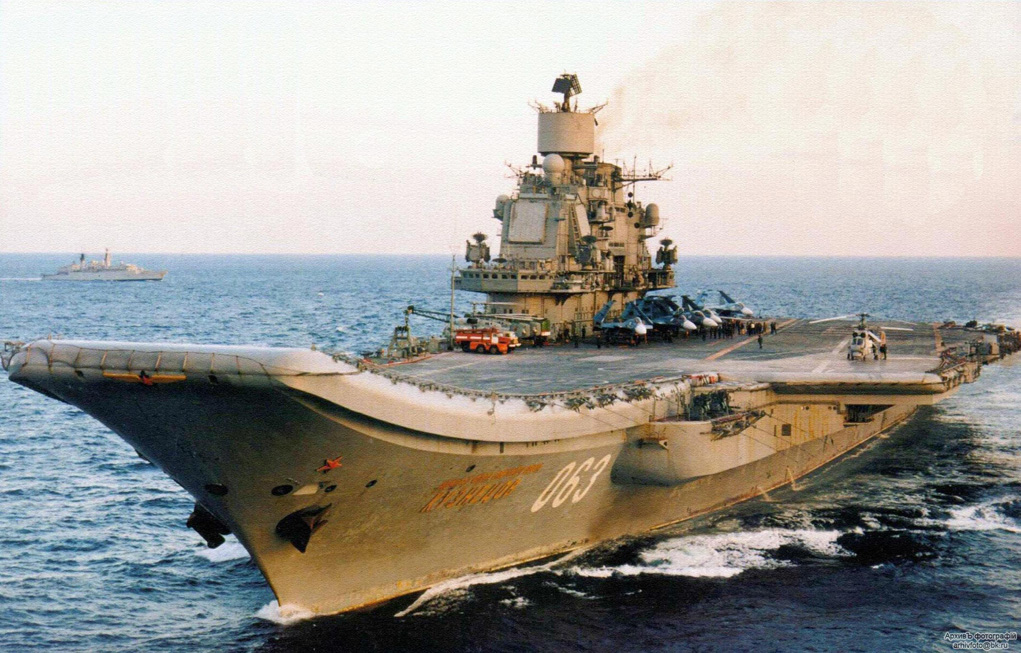The Russian navy is deploying its single aircraft carrier, Admiral Kuznetsov, to head the Russian flotilla in the Mediterranean Sea. It will be the first combat operation for a Russian or Soviet aircraft carrier.
The Russian Navy’s permanent presence in the Mediterranean Sea began in 2013 and includes ten or more warships on average, deployed on a rotation basis from the Northern and Black Sea fleets.
the Russian naval group in the eastern Mediterranean currently consisted of six warships and three or four support vessels at any one time. The force is supported from the main Russian Black Sea Fleet in Sevastopol, Crimea.
Update October 15, 2016: Following the completion of refurbishement the task force left the port city of Severomorsk – the fleet now includes the aircraft carrier, battle cruiser Pyotr Veliky, destroyer Vice-Admiral Kulakov and anti-submarine ships. The Russian defence ministry also announced that Moscow was poised to transform its naval facility in the Syrian port city of Tartus into a permanent base. While en route to its main target – Daesh terrorists, the Kuznetsov is expected to join up with a nuclear submarine, as well as Tu-160 long-range strategic bombers, for anti-piracy and anti-terror exercises before arriving in Eastern Mediterranean where it will join the Russian forces supporting the Syrian regime. In fact, it will be the first combat operation for Admiral Kuznetsov.
Kuznetsov regularly carries an air wing comprising Su-33 air superiority fighters and Ka-27/29 anti-submarine warfare helicopters. Although the Russian Navy planned to modernize the ship, and replace its Su-33 with modern MiG-29Ks, Kuznetsov remains today as it was when it was commissioned in the early 1980s, 34 years ago. To augment its ground attack capability on the current mission in Syria, the Kuznetsov air wing received four MiG-29K fighters that can carry precision guided weapons, while the Su-33 on board received a modernized weapon delivery system (SVP-24) designed to improve ground attack precision with unguided munitions.
The vessel completed minor renovation in August 2015, where it remained for three months in dry dock at Roslyakovo in Kola Bay. This relatively short maintenance period involved cleaning and painting the vessel’s hull, repair of onboard electrical equipment, and a general service of the ship. Additional work was done when the ship was docked at Murmansk but did not include major refit as previously sought. Kuznetsov is a large ship – 305 meters in length, with maximum displacement of 58,000 tons, supporting an air wing of up to 40 fixed and rotary wing aircraft.
The Kuznetsov was due to enter the dry dock in Sevmash in 2012, for an upgrade that would take five years, in which its 3M45 P-700 Granit (SS-N-19 Shipwreck) anti-ship cruise-missile launchers would be removed, clearing more hangar space for fixed wing aircraft. However, delays in the delivery of the Vikramaditya to India prevented such extended work. The upgrade would include the replacement of electronic systems and air defenses on board, replacing the 3K95 Kinzhal (SA-N-9 Gauntlet) missiles with SA-22 Greyhound (Pantsir S1) missiles. None of these upgrades have materialized to date and, apparently, she will remain in its current form until her retirement.

NATO also maintains a strong naval force in the Mediterranean, comprising naval elements of Italy, France and Spain, along with the US 6th Fleet. However, at present, only the French carrier R-91 Charles De Gaulle (CDG) is available to support the Mediterranean, (when sh is not deployed abroad). Since the U.S. decided to shift its focus on the Pacific Ocean there are no aircraft carriers permanently stationed in the Mediterranean Sea. Both French and US carriers are stationed in the Arabian and Indian Ocean, these include the CDG and CVN-75, USS Truman, currently positioned in the Arabian Gulf. Both are tasked with operation Inherent Resolve (the air war against Daesh in Iraq and Syria). At a length of 261 meters the CDG can is a medium size aircraft carrier with a displacement of 42,000 tons, designed to operate 24-40 aircraft. The Truman has a displacement of 100,000 tons; it is 330 m’ long and can operate an air wing comprising up to 90 fixed and rotary wing aircraft.
Two carriers are home based at the atlantic ocean seaport of Norfolk Virginia are the USS Eisenhower (CVN 69) and USS Washington (CVN 73). Two carriers are currently undergoing maintenance at Norfolk – USS Lincoln (CVN 72) and USS Bush (CVN 77). NATO’s availability of aircraft carrier forces is expected to improve with the introduction of two Royal Navy QEII class carriers, along with their air group of 24 F-35B joint strike fighters, which will also augment the Italian Air group on board the Italian Navy Carrier Cavour, currently undergoing modifications to support up to 16 F-35B on board.




















